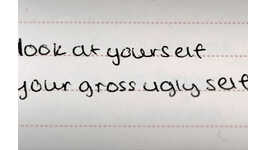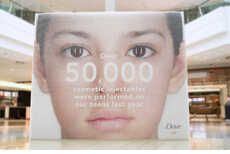
7 Powerful Ads from The Looking Glass
References: adsoftheworld & commercial-archive
DDB Vancouver has created a hard-hitting awareness campaign for The Looking Glass Foundation for Eating Disorders.
They use the tag line, "Not every suicide note looks like one."
The campaign asks us to pay attention to the small signs that indicate a friend or relative is suffering from an eating disorder. The comprehensive campaign consists of print ads, TV spots, and ambient unconventional efforts.
Let's start with the TV spots: Pencil Marks (which you can watch above) shows a girl obsessed with drawing her midriff/belly contours on the wall using a pencil to track how fat/thin she is getting. Dinner Plans and Scales (which you can watch below) show a thin young woman lying to her mom on the phone about already having eaten dinner, and a young thin swimmer weighing herself and writing her alarmingly low weight on a note on the wall, respectively.
The ambient campaign placed items such as broken toothbrushes (see fourth image below) in plastic bags in a department store change rooms and restaurant washrooms in Vancouver. A note is printed on the bag, "Attempting to purge, Jane B., broke a toothbrush off in her throat and choked." Other items left in these places include a hairbrush full of hair and a message, "People with anorexia lose much more than weight," and a spool of thread, revealing "In an effort to end a self-destructive cycle of binging and purging Monica D. passed out attempting to sew her lips shut."
The print ads (images 5, 6, & 7 below) show practices such as having a meal plan that list the calories of everything you eat, tracking your weight on each day of the calendar, and writing an angry diary entry for eating too much that day and wanting to be normal.
They use the tag line, "Not every suicide note looks like one."
The campaign asks us to pay attention to the small signs that indicate a friend or relative is suffering from an eating disorder. The comprehensive campaign consists of print ads, TV spots, and ambient unconventional efforts.
Let's start with the TV spots: Pencil Marks (which you can watch above) shows a girl obsessed with drawing her midriff/belly contours on the wall using a pencil to track how fat/thin she is getting. Dinner Plans and Scales (which you can watch below) show a thin young woman lying to her mom on the phone about already having eaten dinner, and a young thin swimmer weighing herself and writing her alarmingly low weight on a note on the wall, respectively.
The ambient campaign placed items such as broken toothbrushes (see fourth image below) in plastic bags in a department store change rooms and restaurant washrooms in Vancouver. A note is printed on the bag, "Attempting to purge, Jane B., broke a toothbrush off in her throat and choked." Other items left in these places include a hairbrush full of hair and a message, "People with anorexia lose much more than weight," and a spool of thread, revealing "In an effort to end a self-destructive cycle of binging and purging Monica D. passed out attempting to sew her lips shut."
The print ads (images 5, 6, & 7 below) show practices such as having a meal plan that list the calories of everything you eat, tracking your weight on each day of the calendar, and writing an angry diary entry for eating too much that day and wanting to be normal.
DINNER PLANS
SCALES
Trend Themes
1. Awareness Campaigns for Eating Disorders - Opportunity to create impactful campaigns that raise awareness about the signs and dangers of eating disorders.
2. Ambient Advertising - Potential to use unconventional and unique advertising methods, such as placing items in strategic locations, to grab attention and deliver a message.
3. Print Ads with Emotional Appeal - Chance to design print ads that evoke emotion and highlight the harmful effects of eating disorders.
Industry Implications
1. Advertising and Marketing - Innovative approaches in advertising and marketing can be utilized to effectively spread messages about eating disorders and promote awareness.
2. Health and Wellness - Opportunity for health and wellness industries to collaborate with organizations and create supportive initiatives for individuals affected by eating disorders.
3. Psychology and Therapy - Innovation in psychology and therapy practices can contribute to the development of effective treatments and support systems for individuals with eating disorders.
6.5
Score
Popularity
Activity
Freshness















